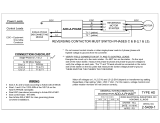
List of Contents
Engineering Information
SINAMICS Engineering Manual – May 2008
Siemens AG
10/396
█ Smart Line Modules........................................................................................................................................... 274
Design................................................................................................................................................................ 274
DC link fuses...................................................................................................................................................... 275
Parallel connections of Smart Line Modules...................................................................................................... 275
█ Active Line Modules + Active Interface Modules................................................................................................ 276
Design................................................................................................................................................................ 276
DC Link fuses..................................................................................................................................................... 278
Parallel connections of Active Line Modules + Active Interface Modules........................................................... 278
█ Motor Modules................................................................................................................................................... 280
Design................................................................................................................................................................ 280
DC link fuses...................................................................................................................................................... 281
Parallel connections of Motor Modules .............................................................................................................. 281
█ Booksize Base Cabinet / Booksize Cabinet Kits................................................................................................ 283
Design................................................................................................................................................................ 283
Booksize Base Cabinet...................................................................................................................................... 283
Booksize Cabinet Kits........................................................................................................................................ 283
DC link fuses...................................................................................................................................................... 284
Planning recommendations, special features..................................................................................................... 284
█ Central Braking Modules.................................................................................................................................... 288
Design................................................................................................................................................................ 288
Position in the DC link configuration .................................................................................................................. 289
DC Link fuses..................................................................................................................................................... 290
Parallel configuration of Central Braking Modules ............................................................................................. 290
Braking resistor.................................................................................................................................................. 290
█ Options............................................................................................................................................................... 292
Option G33 (Communication Board CBE20)...................................................................................................... 292
Option K75 (Second auxiliary busbar)................................................................................................................ 292
Option K82 (Terminal module for controlling the “Safe Torque Off” and “Safe Stop1” functions)....................... 292
Option K90 / 91 (Control Unit CU320)................................................................................................................ 296
Option L08 / L09 (Motor reactors)...................................................................................................................... 297
Option L25 (Withdrawable circuit breaker)......................................................................................................... 297
Option L34 (Circuit breaker on the output side) ................................................................................................. 298
Option L37 (DC coupling)................................................................................................................................... 299
Option M59 (Cabinet door closed) ..................................................................................................................... 299
Option Y11 (Factory assembly of Cabinet Modules into transport units)............................................................ 300
Converter Cabinet Units SINAMICS S150............................................................................................ 302
█ General information............................................................................................................................................ 302
█ Rated data and continuous operation of the converters..................................................................................... 303
█ Factory settings (defaults) of customer interface on SINAMICS S150............................................................... 306
█ Cable cross-sections and connections on SINAMICS S150 cabinets................................................................ 308
Recommended and maximum possible cable cross-sections for line and motor connections........................... 308
Required cable cross-sections for line and motor connections.......................................................................... 309
Grounding and PE conductor cross-section....................................................................................................... 309
█ Load-side components and cables .................................................................................................................... 311
Motor reactor...................................................................................................................................................... 311
dv/dt filter plus VPL............................................................................................................................................ 311
Sine-wave filter .................................................................................................................................................. 311
Maximum connectable motor cable lengths....................................................................................................... 311




















